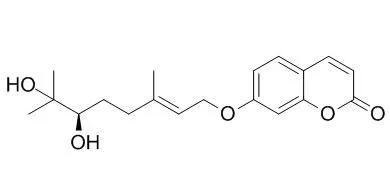| Description: |
Marmin have anti-ulcer effects, which are ascribed primarily to the maintenance of the mucosal barrier integrity and inhibition of gastric motor activity and secondarily due to the prevention of the effects of endogenous acetylcholine and histamine. It can inhibit contraction of the guinea-pig tracheal smooth muscle, especially by interfering histamine receptor, inhibiting the histamine release from mast, inhibiting intracellular Ca2+ release from the intracellular store and the Ca2+ influx through voltage-dependent Ca2+ channels. Marmin shows a cell-growth inhibitory effect against L1210 and K562 in vitro.S-trans-Marmin shows potent antibacterial, fungicidal, and algicidal properties. Marmin, skimmianine, aegeline, aurapten, zeorin, and dustanin are potential to develop as antihistamine agents, especially as histamine H1 receptor antagonists by interacting with amino acid residues, Asp107, Lys179, Lys191, Asn198, and Trp428 of histamine H1 receptor. |
| In vitro: |
| Pak J Pharm Sci. 2011 Oct;24(4):427-33. | | Effects of marmin, a compound isolated from Aegle marmelos Correa, on contraction of the guinea pig-isolated trachea.[Pubmed: 21959801] | Marmin or 7-(6',7'-dihydroxygeranyl-oxy)coumarin is a compound isolated from Aegle marmelos Correa.
METHODS AND RESULTS:
In the study, we examined the effects of Marmin on the contraction of guinea pig-isolated trachea stimulated by several inducers, namely histamine, metacholine, compound 48/80. We also evaluated its action against contraction induced by extracellular or intracellular calcium ion. The possibility of Marmin to potentiate the relaxation effect of isoprenaline was also studied. Marmin added in the organ bath at 10 min prior to the agonist inhibited the contraction elicited by histamine and metacholine in a concentration-dependent manner. Moreover, Marmin antagonized the histamine-induced contraction in competitive manner. Marmin mildly potentiated the relaxation effect of isoprenaline. In the study, Marmin abrogated the contraction of tracheal smooth muscle induced by compound 48/80, an inducer of histamine release. Besides, Marmin successfully inhibited CaCl(2)-induced contraction in Ca(2+)-free Krebs solution. Marmin also inhibited two phases of contraction which were consecutively induced by metacholine and CaCl(2) in Ca(2+)-free Krebs solution.
CONCLUSIONS:
Based on the results we concluded that Marmin could inhibit contraction of the guinea-pig tracheal smooth muscle, especially by interfering histamine receptor, inhibiting the histamine release from mast, inhibiting intracellular Ca(2+) release from the intracellular store and the Ca(2+) influx through voltage-dependent Ca(2+) channels. | | Bioinformation. 2013 Apr 30;9(8):383-7. | | Interaction of active compounds from Aegle marmelos CORREA with histamine-1 receptor.[Pubmed: 23750086] | The aim of this study is to determine the affinity of six active compounds of Aegle Marmelos Correa, they are (E, R)-Marmin, skimmianine, (S)-aegeline, aurapten, zeorin, and dustanin as antihistamines in histamine H1 receptor in comparison to cetirizin, diphenhydramine and chlorpheniramine as ligands comparison. Previously, in the in vitro study Marmin obviously antagonized the histamine H1 receptor in a competitive manner.
METHODS AND RESULTS:
molecular docking to determine the interaction of ligand binding to its receptor. Lower docking score indicates more stable binding to that protein. Marmin, skimmianine, aegeline, aurapten, zeorin, and dustanin were potential to develop as antihistamine agents, especially as histamine H1 receptor antagonists by interacting with amino acid residues, Asp107, Lys179, Lys191, Asn198, and Trp428 of histamine H1 receptor.
CONCLUSIONS:
Based on molecular docking, Amino acid residues involved in ligand protein interactions were Asp107, Lys179, Lys191, Asn198, and Trp428. | | Yakugaku Zasshi. 1996 Mar;116(3):244-50. | | Studies on the bioactive constituents of Aurantii Fructus Immaturus.[Pubmed: 8721353] | An ethanol extract of "Kijitsu" (Aurantii Fructus Immaturus, Citrus aurantium L.) collected in China was assessed for the antitumor activity using murine leukemia P388 in vivo, and the extract was found to be active by the antitumor bioassay in vivo and in vitro.
METHODS AND RESULTS:
The extract was separated into a petroleum ether-soluble fraction and an ethyl acetate-soluble fraction. Fractionation was carried out using an index of cell-growth inhibitory activity against mouse leukemia L1210 cells to isolate antitumor active substances or compounds. The active compounds were purified employing silica gel column chromatography and HPLC. The antitumor effect of the isolated active compounds was studied. Five compounds, auraptene, Marmin, tangeretin, nobiretin and 5-[(6',7'-dihydroxy-3',7'-dimethyl-2-octenyl)oxy]psoralen were isolated from Citrus aurantium L. Though they are all known compounds, 5-(6',7'-dihydroxy-3',7-dimethyl-2-octenyl)oxy-psoralen from this plants was first isolated.
CONCLUSIONS:
These compounds showed a cell-growth inhibitory effect against L1210 and K562 in vitro. |
|
| In vivo: |
| Jpn J Pharmacol. 1994 Sep;66(1):139-47. | | Pharmacological profile of gastric mucosal protection by marmin and nobiletin from a traditional herbal medicine, Aurantii fructus immaturus.[Pubmed: 7861659] | We studied the effects of Marmin and nobiletin on the experimental acute gastric lesions, gastric transmucosal potential difference (PD) and gastric motor activity in rats and the contractions of isolated guinea pig ileum.
METHODS AND RESULTS:
Oral administration of Marmin and nobiletin inhibited both the appearance of ethanol-induced gastric hemorrhagic lesions dose-dependently in a dose range of 10-50 mg/kg, with ED50 values for Marmin and nobiletin being 17.2 and 8.0 mg/kg, respectively. However, Marmin and nobiletin had minimal effects on aspirin-induced gastric lesions at a dose of 50 mg/kg, respectively. Marmin and nobiletin had no significant influence on the basal PD. Intragastrical administration of Marmin and nobiletin at a dose of 25 mg/kg significantly prevented the PD reduction induced by ethanol. Both Marmin and nobiletin given intragastrically at 25 mg/kg significantly inhibited gastric motor activity measured as intraluminal pressure recordings. Marmin and nobiletin exhibited concentration-dependent relaxations of contractions induced by acetylcholine, transmural electrical stimulation and histamine in isolated guinea pig ileum, respectively.
CONCLUSIONS:
These findings suggest that the anti-ulcer effects of Marmin and nobiletin are ascribed primarily to the maintenance of the mucosal barrier integrity and inhibition of gastric motor activity and secondarily due to the prevention of the effects of endogenous acetylcholine and histamine. |
|






 Cell. 2018 Jan 11;172(1-2):249-261.e12. doi: 10.1016/j.cell.2017.12.019.IF=36.216(2019)
Cell. 2018 Jan 11;172(1-2):249-261.e12. doi: 10.1016/j.cell.2017.12.019.IF=36.216(2019) Cell Metab. 2020 Mar 3;31(3):534-548.e5. doi: 10.1016/j.cmet.2020.01.002.IF=22.415(2019)
Cell Metab. 2020 Mar 3;31(3):534-548.e5. doi: 10.1016/j.cmet.2020.01.002.IF=22.415(2019) Mol Cell. 2017 Nov 16;68(4):673-685.e6. doi: 10.1016/j.molcel.2017.10.022.IF=14.548(2019)
Mol Cell. 2017 Nov 16;68(4):673-685.e6. doi: 10.1016/j.molcel.2017.10.022.IF=14.548(2019)